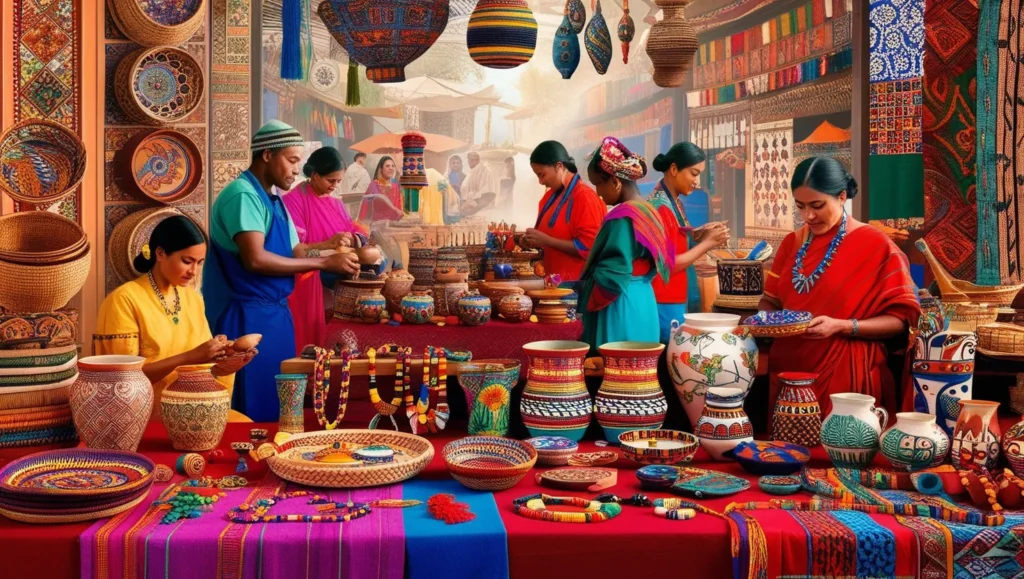Influence of Cultural Traditions in Handicrafts
Handicrafts are more than just decorative objects or functional items—they are a reflection of cultural heritage, tradition, and artistic expression. Influence of Cultural Traditions in Handicrafts Across the world, different cultures have developed unique styles, techniques, and materials that tell the story of their history, beliefs, and way of life.
From intricate Indian embroidery to Japanese origami, from African beadwork to Mexican Alebrijes, handicrafts preserve the soul of civilizations and pass them down through generations In this blog, we will explore how cultural traditions shape handicrafts, why they are important, and how they continue to thrive in the modern world.
The Connection Between Culture and Handicrafts
Handicrafts are deeply tied to local traditions, rituals, and everyday life. Each piece, whether it’s a woven basket or a carved wooden mask, carries the essence of a community’s history, values, and identity. Here’s how culture influences handicrafts:
🌍 1. Regional Materials and Techniques
The natural environment plays a key role in determining the materials and techniques used in handicrafts.
- India – Silk and cotton weaving traditions (Banarasi silk, Kanchipuram sarees)
- Japan – Pottery and porcelain (Raku, Arita, Imari ceramics)
- Africa – Beadwork using locally sourced stones and shells
- Scandinavia – Woodcarving and intricate embroidery using wool
Different regions adapt their crafts based on climate, resources, and needs.
🎨 2. Symbolism and Meaning in Designs
Cultural motifs and symbols carry deep meanings in traditional handicrafts.
- Chinese porcelain – Dragon and phoenix motifs symbolize power and prosperity Influence of Cultural Traditions in Handicrafts
- Native American pottery – Geometric patterns represent nature and spiritual beliefs
- Mexican Talavera tiles – Bright colors reflect the country’s vibrant traditions
- Persian carpets – Floral and arabesque patterns symbolize paradise and eternity
Handicrafts aren’t just about beauty—they communicate stories, beliefs, and history.
🏛 3. Handicrafts in Rituals and Celebrations
Many cultures use handmade crafts in festivals, weddings, and religious ceremonies.
- India – Rangoli (colored sand art) during Diwali
- China – Red paper cuttings for Lunar New Year
- Africa – Handmade masks used in spiritual rituals
- Mexico – Sugar skulls for Día de los Muertos
These handicrafts strengthen cultural identity and bring people together.
🛍 4. The Role of Handicrafts in Economic Growth
Traditional handicrafts are a major source of income for many artisans.
- Local markets and fair-trade organizations help sustain artisans.
- Tourism boosts demand for handmade souvenirs and heritage crafts.
- Online platforms (Etsy, Instagram) allow global access to cultural crafts.
Promoting traditional craftsmanship ensures that these skills don’t disappear in an industrialized world.
Famous Handicrafts Around the World
✨ Indian Block Printing – Hand-printed textiles from Rajasthan
✨ Japanese Origami – Intricate paper folding with cultural significance
✨ Turkish Iznik Tiles – Hand-painted ceramic tiles with Ottoman designs
✨ Moroccan Zellige – Colorful geometric mosaic tiles
✨ Guatemalan Worry Dolls – Handmade dolls used to ease worries
✨ Russian Matryoshka Dolls – Nesting wooden dolls representing family and continuity
Every craft tells a story and connects generations to their cultural roots.
Preserving Traditional Handicrafts in the Modern Age
🌱 Education & Training – Teaching younger generations traditional skills
🛍 Supporting Local Artisans – Buying from ethical and sustainable sources
🎨 Fusion of Tradition & Innovation – Blending traditional methods with modern designs
📱 Using Social Media – Promoting crafts globally through online platforms
By valuing handmade products, we help keep cultural heritage alive!
Final Thoughts
Handicrafts are more than just decorative items or functional objects; they are a living testament to human creativity, cultural identity, and ancestral wisdom. Each handcrafted piece carries within it a story—of tradition, skill, and the hands that meticulously shaped it. From the delicate embroidery of India to the intricate wood carvings of Africa, these crafts represent centuries of knowledge passed down through generations.
In a world driven by mass production, handicrafts remind us of the value of slow, intentional artistry. They celebrate uniqueness over uniformity, sustainability over waste, and authenticity over imitation. Influence of Cultural Traditions in Handicrafts Whether it’s a handwoven textile, a painted ceramic, or a carved wooden mask, every piece holds the essence of a culture, preserving its legacy for the future.
Supporting handicrafts means more than just purchasing a handmade product—it means keeping traditions alive, empowering artisans, and appreciating the soul behind the craft. As we move forward in a digital age, it’s essential to honor and promote these cultural treasures, ensuring that they continue to thrive.

